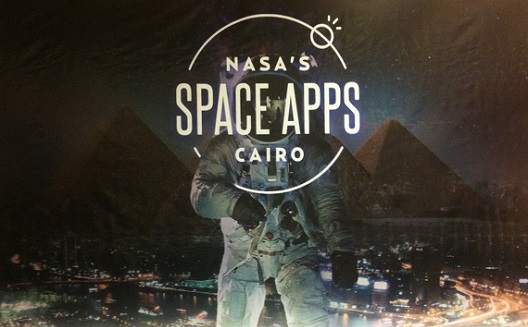Space Apps Challenge takes Egyptians from infinity to beyond


Egyptian students, engineers and whizzkids breathed life into
their 'moonshot' ideas. (Images via Eduard Cousin)
Cairenes were seeking the stars over the weekend, bringing science fiction to life and solving, if not intergalactic then space-age problems during NASA’s International Space Apps Challenge.
Fifty-five teams worked through the night on projects that included a simulation program for drones to operate in restrictive conditions, models for vehicles on Mars, a detector for space debris to protect astronauts, and a virtual reality app to experience a rocket launch.
“Teams spirits are really great, the ideas are amazing,” said mentor and Cairo University engineering graduate Mohamed Emera of the 48 hour hackathon. “[The ideas] can be a mobile application, software, hardware.” April 23
The Cairo edition of the annual, global challenge took place over April 23-24 and is reputedly the largest among the 194 cities that take part.

The final pitch.
The competition, which launched in 2012, asked teams to solve six key challenges:
-
Astronautics - challenges related to drones and airspace
-
Earth - challenges include measuring icecaps for sea transport, and agricultural information for local communities
-
Space Station - related to improving conditions for astronauts in space stations
-
Technology - designing rockets and space suits
-
Solar system - exploring asteroid mining, mapping near earth objects and educating children about the Moon
-
Journey to Mars - challenges centred around virtual reality programmes simulating conditions on Mars
On to NASA
From every city two teams are chosen to compete in the global challenge.
Cairo’s big prize was won by Five Shots, a group of school students, and Orion, a group of five third year students in communication and electronics at Alexandria University.
Five Shots developed a video game simulating life on Mars, using physics equations to realistically reflect the conditions on Mars.
Orion designed a tool to be attached at the arm of a space suit, which measures conditions of the astronaut and his surrounding and sends this information to the space station. The wearable also allows the astronaut to communicate directly with Earth, for instance with a doctor if needed.

Orion's design: the ultimate iPhone.
The teams now need to submit a one-minute video to a NASA judging panel to try to win an invitation to Houston - last year the winners attended the rocket launch to the International Space Station in Florida in September 2015.
Orion teammates Mo’men Ahmed Ibrahim and Amr Ahmed Hassan were ecstatic after collecting the award. “We are very excited, we worked very hard and were aiming for winning. We did what we had to do to accomplish that,” Hassan said.
Ibrahim added that working hard and teamwork were their keys to success. “We divided the tasks, to have a good distribution of the work, and worked through the night to finish our prototype.”
A judging panel of university professors and industry experts chose one winner from each of the six tracks, who will receive training at Egypt’s National Authority For Remote Sensing & Space Sciences (NARSS).
Solving intergalactic emergencies

“Last year was a good start, to learn what it takes to be part of the challenge,” said Hamza. Winning teams in 2015 included a design for a drone, SuperCopter, that could operate both with earth gravity as in space, and PSC-BA CubeSAT from the Outer Space category.
Hamza said Cairo’s teams were not strong competitors last year, whereas this year they might be in with a shot at the top 25. “This year we have high hopes for strong solutions, that are able to compete in the global challenge,” she said.
This year Cairo had the highest number of applicants for the challenge worldwide (1,500), and 250 participants competed. The challenge included 10 teams of school students.
To infinity and beyond
Egyptian and NASA aerospace engineer Tahani Amer
(right, image via NASA) told the teams via Skype that to succeed in
the competition they’d have to trust their team members and learn
from each other. “We are turning science fiction into facts
 and reality,” she
said.
and reality,” she
said.
Professor Alaa Ibrahim from the Zewail City for Science and Technology, and former NASA employee, said “the stars offer infinity opportunity, so keep your dreams big”.
But for Institute of Electrical and Electronics Engineers (IEEE) Egypt member Khaled Mokhtar, the stars were on Earth.
“Our goal this year is competing in the global challenge. And we have several very strong teams,” he said. “This is a great experience and super motivating for Egyptians interested in space technology… Egypt has an upcoming community of startups and entrepreneurship, and this event opens up a totally new field.”
Not everyone was happy, though. Helwan University computer engineer Abdel Moneim thought the competition was better last year.
“There was more support, like transportation, places to sleep if you wanted to stay overnight,” he said. The challenges outlined by NASA were also a “little disappointing” as he saw fewer opportunities to develop hardware solutions in those categories. “The challenges now are more towards software and virtual reality,” the engineer said, who dreams of working for NASA one day.
But it was the hope of the big idea that caught imaginations.
“I like the idea of giving people the opportunity to dream big,” said Sara Hazem, a biomedical student at research centre Zewail City for Science and Technology. “People need that in this country, and they need someone from outside to tell them [to dream big].”
Next goal is NASA, from there, the stars.


